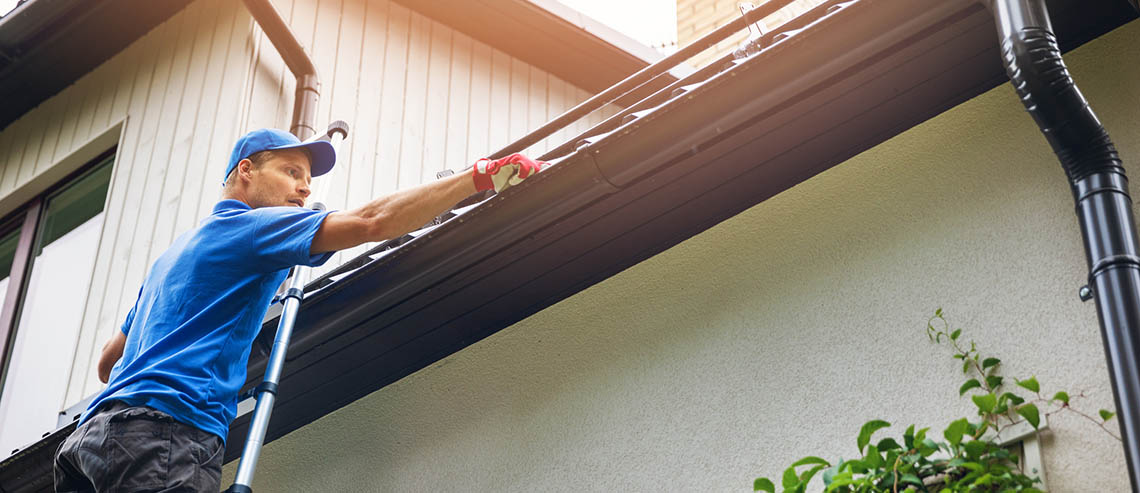
Earn cash back
after close!
With Home Connect, you could earn $350 to $9,500 cash back after close.
Would you rather repair a small crack or rebuild an entire wall? How about cleaning a filter versus replacing your entire air conditioning unit? Both examples illustrate the importance of regular home maintenance and how taking care of small tasks can help you avoid bigger—and much more expensive—issues in the future.
Let’s explore some indoor and outdoor home maintenance essentials to add to your to-do list and how to budget for repairs. Whether you just bought your first house or recently moved to a new one, following this home maintenance checklist can help keep your property safe, sound and comfortable.
Why Maintenance is Critical
Home maintenance is about more than aesthetics — it’s also about functionality. Regular checks and timely repairs can prevent minor issues from escalating, saving you money and reducing wear and tear. For many of us, our home is our biggest investment, and proper maintenance can protect that investment and help it increase in value.
How do you keep up with it all? Breaking down the tasks by season and frequency intervals, such as monthly, quarterly, etc., can help you plan and stay on track. This checklist is a general guide and can be a great starting point.
Winter Maintenance Checklist
Address the essentials to keep your home warm and protected from the cold.
Schedule Heating System Tune-Up
Schedule a heating system tune-up at the beginning of the season to ensure everything works properly. Remember that an inefficient heating system can make it work harder, increasing running costs. You’ll also want to pay extra attention to your furnace filters and keep the temperature inside your home to at least 55 degrees, even if you will be gone.
Prevent Freezing Pipes
To prevent sink pipes from freezing and potentially bursting on frigid days, open the cabinet doors below the sink or run a trickle of hot water. Exterior pipes can also freeze, so consider turning off the supply valves to the outdoor faucets before the temperatures drop.
Inspect Roof and Gutters
In early winter, check your roof for any signs of damaged or missing shingles. Keep gutters and downspouts clear of accumulated ice and snow throughout the season.
Stock up on snow removal supplies, such as snow shovels and a roof rake to remove snow from the roof. Too much heavy snow on the roof can cause ice dams, an ice formation at the roof edge that prevents ice from draining and can lead to leaks and other interior home damage.
Check Home Safety Equipment
Winter demands extra vigilance for home safety primarily due to the increased use of heating systems, fireplaces and other heat sources that pose fire hazards and carbon monoxide risks. Start by testing and replacing the batteries in your smoke detectors and carbon monoxide alarms to ensure they function properly.
Spring Maintenance Checklist
Prepare your home for the warmer months with a focus on outdoor and system maintenance.
Prepare the Air Conditioner
Prime your AC in the spring before the high temperatures hit. Schedule a professional inspection to clean filters, check refrigerant levels and ensure all components function efficiently. This proactive maintenance helps prevent breakdowns during the summer heat and can keep your cooling costs in check.
Clean Interior and Exterior
Warmer weather means you can do that all-important spring cleaning, both indoors and outdoors. Declutter and organize your home from top to bottom. Powerwash your home’s exterior, as well as walkways, decks and patios.
Inspect Home Exterior
Check for clogged gutters and downspouts and remove any debris. Survey your roof for any signs of wear and tear and check the flashing on your chimney to ensure it's secure and watertight, preventing any water damage as the seasons change. Repair any issues you uncover.
Clear Yard and Landscape
Spring is the perfect time to revitalize your yard. Start by clearing winter debris and pruning overgrown plants to encourage growth. Reseed bare patches in your lawn, fertilize plants and apply mulch to retain moisture and suppress weeds. Start up your sprinkler system, either yourself or call your watering system provider.
Summer Maintenance Checklist
Concentrate on optimizing comfort and your home’s exterior during hot weather.
Check Windows and Doors
Check the seals around windows and doors for any cracks or gaps that can let hot air in and cool air out, increasing your energy bills. Re-caulk any problem areas. You’ll also want to ensure that all hinges and locks function correctly for security and efficiency.
Control Pests
Summer heat brings pests. Inspect your home for signs of infestations, particularly termites, ants and mosquitoes. Clear away any standing water, seal entry points and consider professional pest control treatments if necessary to keep your home pest-free.
Inspect Deck and Patio
Inspect your deck and patio for wear or damage. Look for loose boards or unstable railings, and check for signs of wood rot or deterioration. Summer is the ideal time to repair, reseal or repaint these areas to protect them from the elements and to keep them looking great for outdoor activities.
Paint
Take advantage of the warm weather to do some exterior painting. Check your home’s exterior for chipped or peeling paint, and apply a fresh coat to protect the siding and trim from weather damage and to boost curb appeal. When painting outdoors, choose a day with moderate temperatures and lower humidity.
Fall Maintenance Checklist
Ensure your home is ready for the drop in temperature and upcoming winter conditions.
Inspect and Clear Gutters and Downspouts
Make sure that your gutters and downspouts are securely attached and clear of leaves and debris. Take steps to repair and clean anything that requires it, whether you do it yourself or hire a pro.
Weatherproof
Weatherproofing can help you stay warm and reduce energy costs. Seal any gaps around windows and doors to prevent cold drafts, and add insulation to attics and basements as needed.
Schedule Chimney and Fireplace Inspections
Schedule a professional inspection and cleaning to remove built-up soot and debris and check for structural issues that could affect safety. Regular maintenance helps prevent chimney fires and carbon monoxide buildup, ensuring your fireplace is safe and efficient for those cozy, chilly evenings.
Year-Round Home Maintenance Tips
Performing consistent home maintenance can help preserve the structure and systems in your home. Although these tasks need to be done throughout the year and at varying intervals, most of them are relatively easy and inexpensive.
Monthly Tasks
Check and clean kitchen vent hood filter: These filters trap grease and dust, keeping your kitchen clean. They are less effective when clogged, but thankfully many of the metal, reusable filters can easily be run through the dishwasher.
Look for leaks in and around sinks and toilets: Stopping a small drip right away can prevent damage to your cabinets, floors and even the rooms below.
Check and potentially replace HVAC system filters: How often you need to do this depends on your climate, system type and other factors, but a good rule of thumb is to change the filters once every 90 days.
Inspect fire extinguishers: Having an accessible, functional fire extinguisher can keep a small mishap from turning into a huge amount of damage—and worse. Make sure that you have extinguishers ready where you need them.
Clean kitchen sink disposal: Can’t find the source of that yucky smell in your kitchen? It may be your garbage disposal. Clean it by adding ½ cup of baking soda, then ½ cup of vinegar. After the foaming subsides, flush it while running with hot water.
Pay attention to your utility bills: A sudden unexplained jump in your water, electric or gas usage could be a clue to a hidden problem. You'll want to investigate further to determine the root of the issue.
Quarterly Tasks
Flush toilets and run water in rarely-used spaces: Unused bathroom drains can get smelly. This is because the water held in the p-trap that normally blocks sewage smells can evaporate. Taps and valves can also seize up if unused for long periods of time.
Check your water softener: Check for leaks, and add salt or other water softening agents, if needed.
Inspect and touch up caulking and grout: Replace moldy, separated or otherwise damaged grout. Ensuring that all seams, both indoors and out, stay sealed will prevent water damage, save on utility bills and help to keep pests out.
Test smoke and carbon-monoxide detectors: Most of these life-saving devices can easily be tested with the push of a button.
Deep clean your entire home: Tackling this sizable project every three months prevents your cleaning tasks from becoming overwhelming.
Bi-annual Tasks
Replace batteries in smoke and carbon-monoxide detectors: Planned replacement will ensure your detectors are working in case of an emergency and will also prevent low batteries from beeping. A popular practice is to coincide battery checking and replacement with changing the clocks for daylight saving time in the spring and fall.
Vacuum refrigerator coils: These coils release the heat produced by the condenser that keeps your fridge cold. When they are dirty, they don’t work as well, causing your fridge to work harder, use more power and even potentially fail. They are typically on the back of your fridge or at the bottom of the front behind a grate. Clean them with a soft brush and a vacuum with a hose attachment.
Test your water heater pressure relief valve: This valve releases any excessive buildup of heat or pressure within your water heater, preventing a messy and damaging explosion. To test the Temperature Pressure Relief (TPR) valve, lift it up and down several times, which should lift the attached brass stem allowing hot water to flow from the drainpipe. Should little to no water come out, you’ll need to contact a plumber to replace the valve. If water does continue coming out of the valve, go ahead and raise and lower the valve to clear up debris.
Have your air conditioner drain line flushed: This process, which you can even do yourself, prevents messy, damaging leaks. Be sure to check your drip pan for leaks as well.
Keep in mind, however, that while some projects are suitable for DIY, other more complex and dangerous tasks are better handled by professionals. Always err on the side of safety.
Essential Tools Every Homeowner Should Have
From simple repairs to more complex projects, having the right tools on hand can save time, money and stress. Here’s a list of essential tools that can help you tackle many home maintenance tasks.
Adjustable Wrench: Useful for dealing with various sizes of nuts and bolts
Allen Wrench Set: Often needed for assembling flat-pack furniture and bicycles
Duct Tape and Electrical Tape: For temporary repairs and electrical work
Electric Drill and Drill Bits: For drilling holes and driving screws more efficiently than manual screwdrivers
Flashlight: Handy during power outages and working around the home
Hammer: A versatile tool for driving nails, fitting parts and disassembling items
Ladder: Makes tasks like painting, cleaning gutters and changing light bulbs easier and safer to complete
Level: Ensures pictures and shelves are perfectly horizontal
Pliers: Essential for gripping, bending and cutting wire
Safety Glasses and Gloves: For protection during various indoor and outdoor tasks
Saw: Useful for cutting wood for numerous home improvement projects
Screwdrivers (Flathead and Phillips): Essential for assembling furniture, tightening hardware and more
Stud Finder: Essential for locating studs in the walls for hanging heavy items safely
Tape Measure: Necessary for accurate measuring when hanging pictures, remodeling, or purchasing new furniture
Utility Knife: Great for opening boxes, cutting carpet and other tasks
How Much Should You Budget For Home Maintenance?
So what do all these maintenance tasks cost? Maintenance expenses should be included in your budget, as they’re an integral part of the "true cost" of owning a home. Although expenses vary by individual and home, there are several methods to estimate your budget for home repairs.
The 1% Rule: The 1% rule is a rough guideline that suggests setting aside at least one percent of your home’s value every year for home maintenance. For example, with a $450,000 house, this comes out to $4,500 per year for maintenance.
The Square Foot Rule: The Square Foot Rule suggests saving $1 for every square foot of your home annually for maintenance. For instance, for a 1,500-square-foot home, set aside $1,500 each year. While you might not use the full amount annually, it typically averages out over time. Note that this rule doesn't include labor and materials costs, so actual expenses may vary if you hire professionals for repairs.
Of course, both of these “rules” are just guidelines. Major repairs, such as a roof replacement, will have much higher costs.
Other factors to consider when budgeting for home maintenance include:
House Age: Most older homes require more maintenance, and the age of your appliances and other major systems needs to be considered as well.
Location: Your location—whether it's the humid south, the hot, dusty desert, or the freezing, snowy north—affects the type of maintenance your home requires.
Overall Condition: Did you buy a vintage fixer-upper or a totally updated turn-key? Your home’s overall condition will impact your budget, as one big issue, like a leaky roof, can lead to other smaller maintenance priorities.
House Type: The suburban single family home with a large yard will require a bigger outdoor maintenance budget than a condo with a small patio (and an HOA that performs all exterior maintenance).
Using a Home Equity Loan to Manage Maintenance Costs
Many homeowners take pride in maintaining their homes, not only to preserve and enhance their investment but also to ensure a comfortable and enjoyable living space. If you're considering significant home improvements or repairs, a home equity loan could provide the needed funds. Speak with a Pennymac Loan Expert today and explore how financing and tapping into your home equity could help you keep your property in top shape.
Share
Categories


Meet Our Contributing Editors
Bradley Thompson and Afton Lambert are Contributing Editors for Pennymac’s consumer content and are exemplary leaders within the mortgage industry space. Both experts take pride in helping our customers achieve and sustain their aspirations of home.
For over 13 years, Bradley has achieved success as a high performer in various leadership roles including consumer direct sales and mortgage fulfillment positions.
With over 10 years of mortgage experience, Afton started her career as a top performing Loan Officer, before transitioning into her leadership role, where she has recruited, hired and trained Loan Officers.





